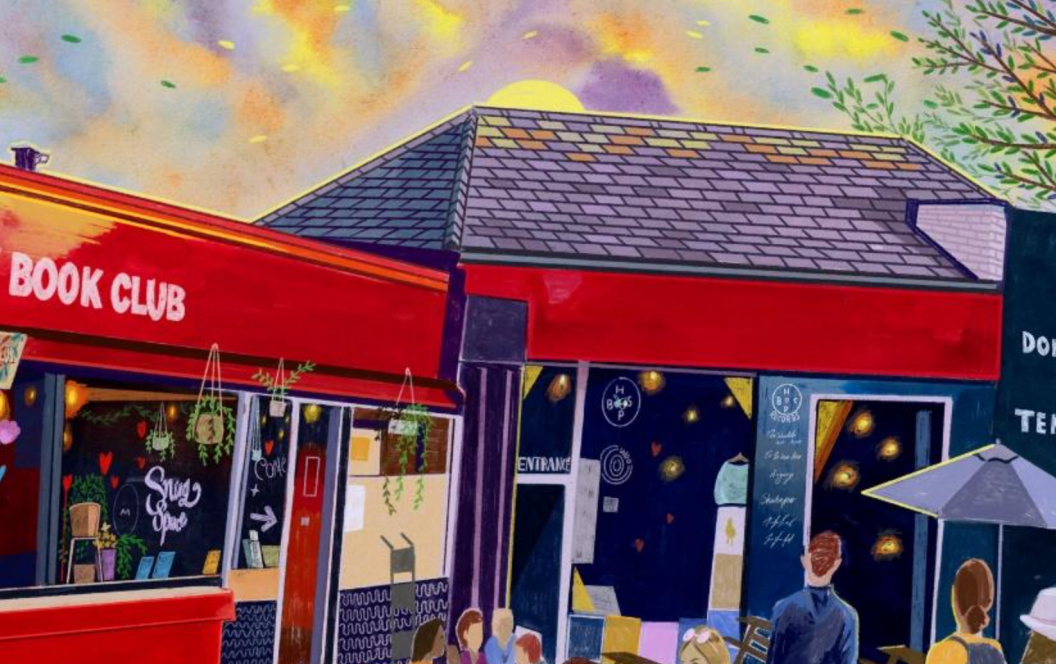A guy in his 20s bought a black americano and sat in the corner of the café where I work, and when I took over his coffee he was peeling back the first pages of Exteriors by Annie Ernaux, translated by Tanya Leslie and published, unmistakably, by Fitzcarraldo Editions. The cover was Klein blue text on a plain white papery background (to signal essay — the colours reversed would signal fiction). I blurted, as I walked past his table, I love that book, placing his coffee down before askingif he’s read any other Ernaux, which he hadn’t. He seemed pleased though — as if he had been doubtful — by my brief, enthusiastic backing of the book. One of my favourite writers, I said, continuing to walk away in the other direction.

I can absolutely tell you I would have commented on that book regardless of the title (maybe less to substantiate my claim if I hadn’t read it). Design is (clearly) always on our minds here at NDF, and this got me wondering how such a simple cover could incite my knee-jerk reaction. It all comes back to this: Fitzcarraldo Editions’ covers have become a lighthouse for the quality of their books. Reminiscent of traditional French publishing, such as Gallimard and Les Éditions de Minuit, they are stripped back: regardless of content, their books have the same or similar cover design, shifting emphasis from author or narrative, to publisher. Titles are woven into the same family through aesthetic connection, rather than a cover design attempting to express some key quality of the book or fitting a schema for the genre. In this pattern of nearly identical covers, the wild variations of each writer are not described or even referenced, other than in their name. The publisher is telling you they trust this book, and you should too.
Some small publishing houses in the UK — such as Prototype Publishing, Peninsula Press, Les Fugitives and Joan Publishing — have also taken this design route, and, in 2023, Northern publishing house And Other Stories joined them. And Other Stories (bearing no relation to the clothing brand ‘& Other Stories’, though my feed is now filled with their ads), publish contemporary literary and short fiction, including plenty of translations and Northern writers. Founder Stefan Tobler used to be a translator, so it is no wonder the variety of writers whose words land in our lap via the Sheffield-based publisher. Within their first year they published Swimming Home, a novel by Deborah Levy that gained substantial critical and commercial acclaim. In 2021, ten years and many stories later, they were awarded the Small Press of the Year for the North of England at the British Book Awards. They are one of the first Northern publishers to use a house cover design, favouring the collective above the individual.
After a year spent consulting authors and booksellers, they developed this design, which grants a thread of unity to every book, every story. The covers are stripped back, cream card with black foil. Appropriately, typography is at the heart of the design — font Stellage by SM Foundry guides us, eyes flitting line to line amongst pilcrows, arrowing commas and angular brackets. An updated and clarified logo, or small illustrative icon, sits mid-way between the title, hanging at the top of the page above the author's name and a block of extracted text, which is set to the bottom edge. A generous indent invites us in closer. In their words, the concept is simple and radical: we put words first.¹

The book as object has tactility at its heart and these do, as beautiful objects, invite touch. I hold it up to the light; my fingers graze the serif edges, the spine, the silvery black foil. In a similar encounter, two years ago in a Margate bookshop, I picked up the quiet cover (whose quietness spoke more clearly than every other cover on the shelf) of a book published by Les Fugitives: narrow red text, a cream colour filled the page, before a wafery lilac flyleaf caught my finger tips, flickered past: a feeling I remember more than the book itself. And Other Stories’ design, by Brazilian designer Elisa von Randow from Alles Blau studio, impeccably balances a similar simplicity with subtle typographic complexity, resulting in covers that hold attention with unexpected ease. Harnessing tactility, they speak of clarity, reduction; they are undemanding and impeccably alluring. The designer said it was her simplest and most radical idea.
Must a book cover demand attention? Must it tell me something essential about the genre, plot, setting, character, audience, author? Must it provide some elusive detail that will only make sense after I finish reading? Must it illuminate the heart of the story? As if there is ever only one? And will a cover design I take aversion to put me entirely off reading the book, permitting me to judge it in a split second?
Must a book cover demand attention?
There is, of course, something enticing about a cover that manages to express some essential quality of a writer’s work, orbiting the space around the ideas of the text — and if this covers a book I love, it becomes essential to my adoration of that book. On Not Knowing by Emily Ogden, for example. Somebody Loves You by Mona Arshi (by And Other Stories, before their design series came out). Suite for Barbara Loden by Nathalie Léger (I bought a second copy of this one, after reading, in order to see Dorothy a Publishing Project’s cover on my bookshelf). Admiring a good cover is a pleasure, and a good book the same. But a mysterious, beautiful cover on an excellent book? That is symbiosis.
Often there’s a middle ground, where cover design will take a thematic approach, linking multiple titles by an author — works by Lynne Tillman (Peninsula Press) for example, and Deborah Levy’s living autobiography series (Penguin). But these visual languages still place emphasis firmly on the author, and for me, the unique impact a series design can have by shifting emphasis equally to the publisher can be invaluable. It is surely a vital part of learning about smaller or newer publishers of exciting work, in turn helping to move away from London and the South’s monopoly of the publishing industry. Something which And Other Stories continue to pick away through their northern collaborations and sustainable manufacture: The cover stock paper is Colorplan card, as developed by Hull’s world-leading paper merchants, the B Corp-certified G . F Smith. It is made sustainably with FSC-certified paper at the James Cropper mill in the Lake District […] And the cover and spine sport black biodegradable foil.
The resurgence of a series design in indie publishing is an assurance of their loyal belief in the value of books as objects, and the value of the entwined nature of language and visual language. As well as, of course, the trust that great design has the power to do this. It is credit to these energetic industry corners, where the ‘corner’ is constantly expanding, folding, changing shape; briefed by the past, yet looking and moving forward. Design is used to enable a more sustainable and efficient product, whilst also amplifying the publishing house, highlighting their crucial role in bringing the stories of the individual to the collective audience. With this, both the writers and the publishers' work is elevated by the visual and literary aesthetic — the books become art objects. And the bookshops look divine!
For me, the essence of a book can often be found by understanding the threads that connect it to other books, other writers or translators, which, more often than not, particularly with a small press, is the publisher. This essence is a kind family or heritage, tied to a small papery object in my palm. In a series design, every author is on par, regardless of their experience or background, and in trust, we might pick up a book that we would not usually. We begin to read past our borders. Trusting a publisher — essential in a successful design series — is like a friend pushing a book into your hand and telling you it is worth it. The cover itself, though, is an open palm. By never grasping for attention it inevitably commands it.
By never grasping for attention it inevitably commands it.
A publisher, equally and in turn, must respect the reader. We will pick up the book. A series design signals their trust in the readers willingness to engage and to, in fact, read. In a refusal to follow topical genre tropes and trends, the publisher is afforded some kind of timelessness, and this creative restriction — what is, essentially, abstraction — the intent of the publishing house is condensed into an 5x8” singularity.
We are super excited at NDF to see a Northern publisher giving readers this trust, and putting their faith not only in authors, but designers, to bridge this gap. And Other Stories demonstrates the role that cohesive, creative and minimalist design, as well as local and sustainable collaborations, can have in refreshing the landscape of publishing in the north: their strategy of simplicity is written like an invitation.
¹Referenced quotes (in italics): Stefan Tobler and Elisa von Randow, And Other Stories’ Series Design Revealed: Putting Words First. And Other Stories, 16 August 2023 https://www.andotherstories.org/2023/08/16/and-other-stories-series-design-revealed-putting-words-first/




